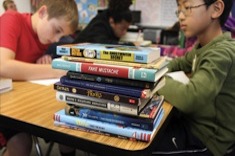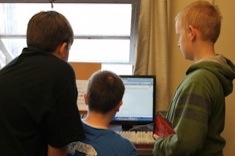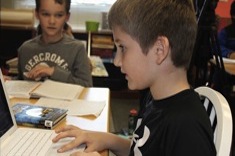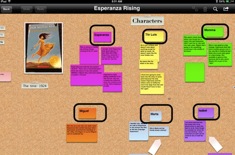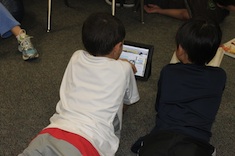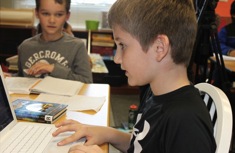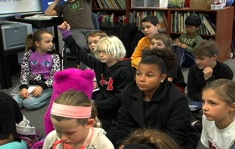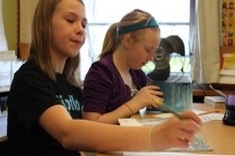Digital Literacy
Thoreau once wrote we are in danger of becoming the "tool of our tools," but it's doubtful he envisioned a day when there would be so much technology hardware and software to distract and empower us at the same time. Teachers who are grappling with iPads, laptops, kid blogs and cellphones in classrooms share their triumphs and struggles here.
Latest Content
Shallow Books? Learning from a Reading Celebration
Franki Sibberson discovers we allow students to assess what reading matters most to them, we can learn a remarkable amount.
Rethinking Technology: The Power of Student Experts
It’s impossible to master all the new technology resources available in classrooms, and fortunately we don’t have to. Katherine Sokolowski enlists peers as tech experts in her fifth-grade classroom.
Reader Response in the Digital Age
Franki Sibberson has suggestions for moving to more digital response options with students.
Digital Boards for Formative Assessment
Katharine Hale has moved much of her reading response to digital boards, which are also a useful tool for formative assessment.
Many Possibilities for Student Podcasting
Katherine Sokolowski shares how she has integrated podcasting into her 5th grade classroom.
Getting Ready for Summer Reading: A Lesson Cycle
Franki Sibberson designs a lesson cycle to prepare students for summer reading.
Connecting Class Social Media in Eight Simple Steps
Colby Sharp shares step-by-step guidance for linking class blogs, Twitter and private Facebook pages when sharing with families. Best of all, you can turn over the task to students.
Getting Started with Blogging in Fifth Grade
Katherine Sokolowski presents some strategies from her fifth-grade classroom for launching student blogs.
Creating Video with Students: Tools and Tips
Bill Bass gives advice and provides resources for creating video with high school students.
Expanding the Literacy Classroom with Flipped Minilessons
Katharine Hale tries some flipped minilessons in her fifth-grade classroom and explains how technology is providing new opportunities for student learning.
Deeper Writing: The Story Behind the Selfie
Gretchen Taylor taps into a cultural phenomenon with her seventh-grade writers to help them deepen their writing and reflection.
Kindle Highlights: Conferring with Nicole
If you’ve ever used a Kindle reader, you might be fascinated by the highlighted notes of other readers. Franki Sibberson uses those notes in a conference with Nicole.
Shared Blogging in the Primary Classroom
Shared reading and shared writing are essential instructional techniques in the primary grades. How about shared blogging for teaching children basic blogging skills? Cathy Mere describes how it works.
Keeping Kids Safe on the Internet
Julie Johnson provides helpful tips and a letter for parents to help keep students safe on the Internet.
Using Pinterest for Professional Development
Franki Sibberson finds Pinterest is a useful tool for professional development.
Helping Students Evaluate Online Video for Research
Even if your district is blocking web video now, it's not going anywhere. As time goes on, schools will rely more and more on video available from the Internet for research and learning. Bill Bass has practical advice for helping middle and high school students assess everything from suspect sources to appalling comments on the Wild Wild Web.
Using Technology to Connect Young Readers and Writers
Julie Johnson reflects on how technology is changing her own reading community, and builds on this knowledge to connect readers and writers in her classroom with others through the Internet.
Fourth Grade Writing Workshop Minilesson on Focusing
Franki Sibberson shares some tips and strategies with her fourth graders from the web for focusing and organizing their writing.
Whole Group Writing Share
Franki Sibberson’s fourth graders use the whole-class writing share time to discuss writing series they are working on (including blog interviews and book reviews), with an eye toward collaborating with classmates.
Using Instagram to Sell Summer Reading Options
Tony Keefer taps into the Instagram craze among his students, and finds it is an ingenious tool for encouraging summer reading while kids are on vacation.
Conferring with Ben
Franki Sibberson confers with Ben, a fourth-grade writer trying to figure out the best audience for his writing when technology presents many options.
Staying Connected with Students All Summer Long
Cathy Mere explains how she uses technology to stay in touch with students and families over the summer.
Conferring with Pierce
Franki Sibberson demonstrates how much ground can be covered in a three-minute conference with a student. She helps fourth grader Pierce think through the audience for his writing, how to add visuals to blog posts, and enlists him to teach others new skills as he acquires them.
Our Favorite Online Reading and Writing Tools Round-Up (Part 2)
Choice Literacy contributors share favorite online tools. This is the second installment in a two-part series.
Our Favorite Online Reading and Writing Tools Round-Up (Part 1)
Choice Literacy contributors share their favorite online reading and writing tools. This is the first installment in a two-part series.
The Lunch Lady and Gender in Reading
Franki Sibberson has her students read a blog post about books written for boys and girls, which begins a fascinating discussion with the class about gender in reading choices.
Embracing the Growth Mindset with Audiobooks
Jennifer Vincent explains how recorded texts were a potent tool for reaching a struggling fourth-grade reader.
Audioboo, QR Codes, and Authentic Reading Response
Katherine Sokolowski uses audio recordings and other tech resources to build her fifth-grade reading community.
Hindsight: What I Wish I’d Known Before My School Burned Down
Melanie Quinn shares lessons from the fire that burned down her school.
The “Tys” of Student Research: Safety and Credibility (Primary Research Series Part 2)
Heather Rader shares the second installment in our primary research series.
Browse Content By
Type
Category
- Assessment Tools
- Big Fresh Archives
- Booklists
- Choice Numeracy
- Classroom Design
- Common Core
- Community Building
- Conferring
- Content Literacy
- Digital Literacy
- English Language Learners
- Equity
- Family Relations
- Free Samples
- Guiding Groups
- Leadership
- Literacy Coaches
- Mentor Texts
- Minilessons
- New Teacher Mentors
- Podcasts
- Poetry
- Quote Collections
- Reading Strategies
- Self Care
- Struggling and Striving Learners
- Talking and Listening
- Teacher Study Groups
- Teaching Reading
- Teaching Writing
- Word Study and Vocabulary
Author
- Melissa Quimby
- Nawal Qarooni
- Gwen Blumberg
- Julie Cox
- The Lead Learners
- Hannah Tills
- Josie Stewart
- Ruth Metcalfe
- Mallory Messenger
- Becca Burk
- Jodie Bailey
- Vivian Chen
- Mary Brower
- Tiffany Abbott Fuller
- Stephanie Affinito
- Ruth Ayres
- Leigh Anne Eck
- Heather Fisher
- Shari Frost
- Julie Johnson
- Suzy Kaback
- Gigi McAllister
- Shirl McPhillips
- Melanie Meehan
- Cathy Mere
- Debbie Miller
- Tara Barnett and Kate Mills
- Tammy Mulligan
- Dana Murphy
- Bitsy Parks
- David Pittman
- Brenda Power
- Heather Rader
- Matt Renwick
- Mandy Robek
- Christy Rush-Levine
- Gretchen Schroeder
- Jen Schwanke
- Brian Sepe
- Katherine Sokolowski
- Stella Villalba
- Jennifer Vincent
Grade Level
Choice Literacy Membership
Articles
Get full access to all Choice Literacy article content
Videos
Get full access to all Choice Literacy video content
Courses
Access Choice Literacy course curriculum and training

